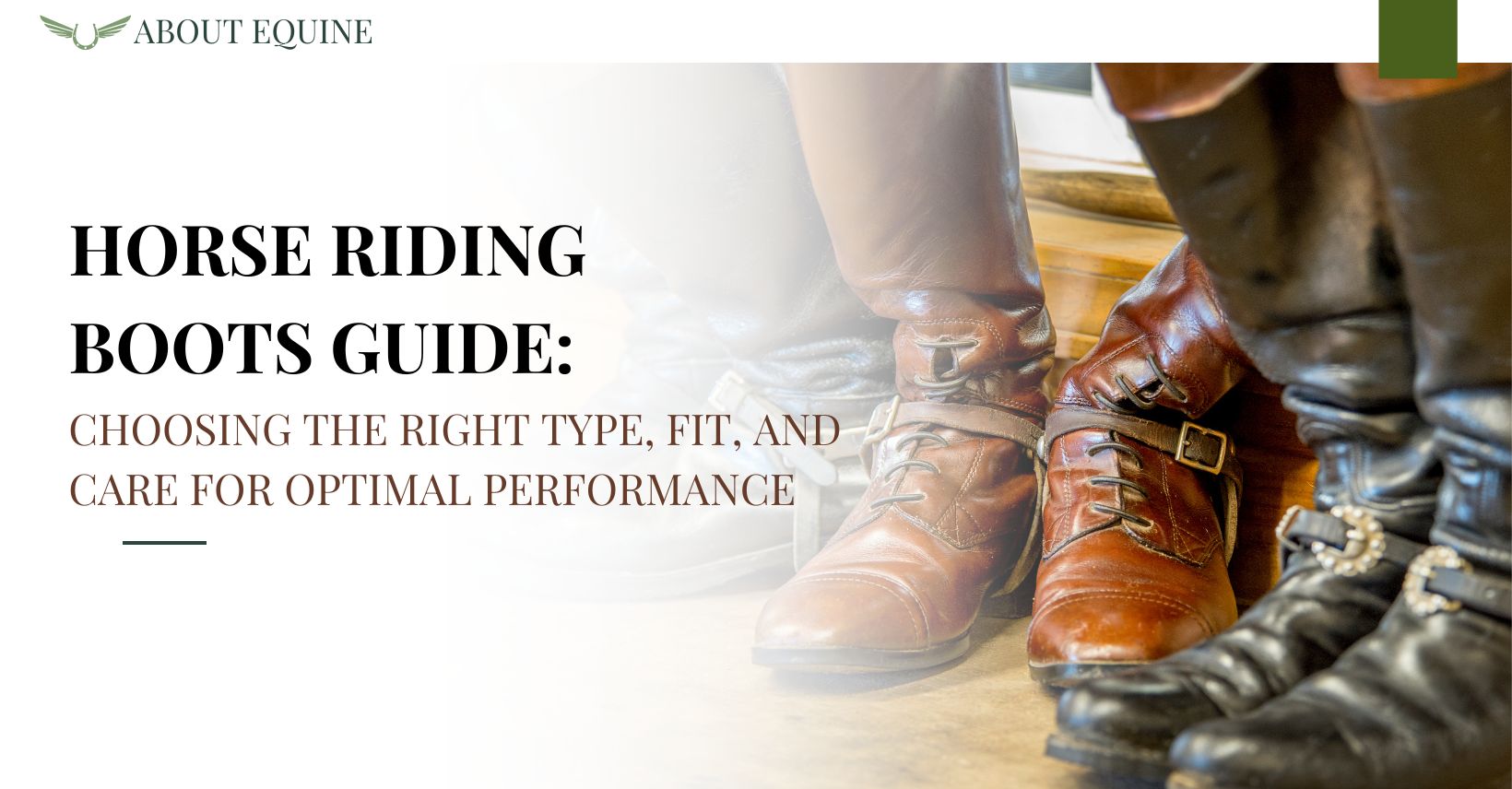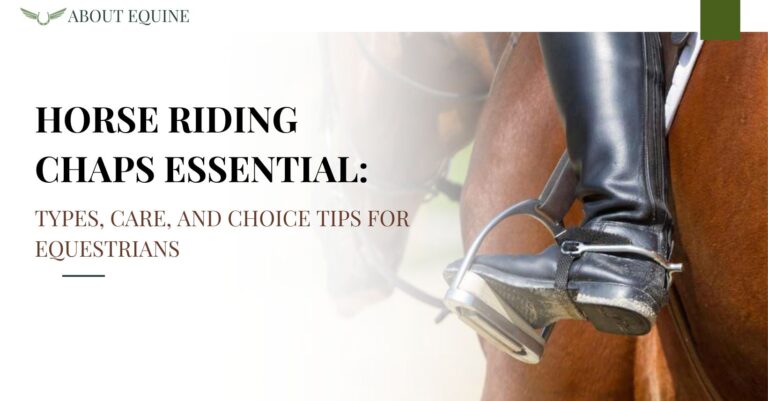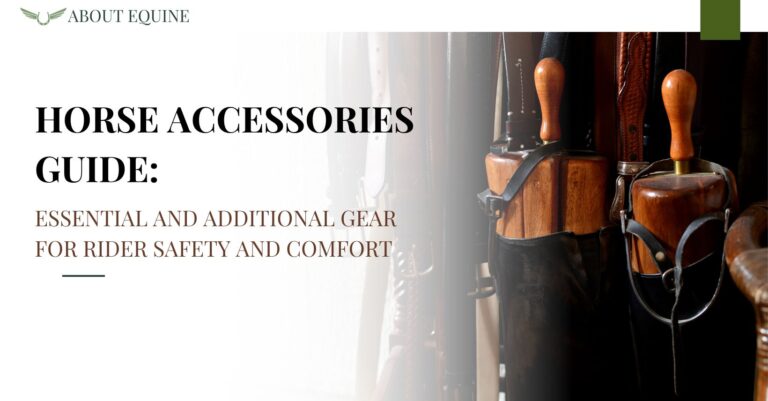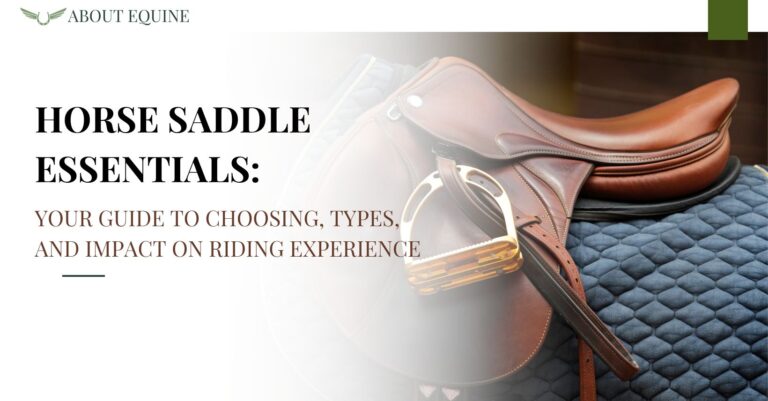Horse Riding Boots Guide: Choosing the Right Type, Fit, and Care for Optimal Performance
Are you using the right horse riding boots for your horse? Choosing the correct type of boots is important for both the rider’s comfort and the horse’s well-being.
We will discuss the importance of selecting the appropriate horse riding boots, the different types available (such as dress boots, field boots, paddock boots, western boots, and endurance boots), and factors to consider when selecting.
We will also cover proper maintenance and care tips, common mistakes to avoid, and, ultimately, how to find the perfect horse riding boots for you and your equine companion.
Why Choosing the Right Horse Riding Boots is Important?
Choosing the right horse riding boots is essential for every rider. These boots ensure protection, comfort, and style. Whether you ride dressage, show jumping, or trail rides, the right boots can greatly affect your experience.
Horse riding boots protect your feet and lower legs from potential injuries caused by the horse’s movements, terrain, or equipment. Properly fitted boots support the ankle and prevent chafing or rubbing during long rides. Comfortable boots enhance your performance and enjoyment – consider the difference between wearing ill-fitting boots and those matching your foot shape and riding style.
Different riding disciplines have unique boot requirements. Dressage riders often prefer tall, elegant boots for a polished look and proper leg support. At the same time, eventers prioritise durability and grip for varied terrains. Knowing what factors to consider when choosing horse riding boots is important to make the best choice for your needs.
What Factors Should You Consider When Choosing Horse Riding Boots?
When selecting horse riding boots, consider calf widths, leg lengths, ankle support, foot size, boot material, and desired flexibility. Measure the widest part of your calf for a proper fit; some boots have specific calf width sizes, while others offer adjustable options.
Choose boots with sturdy construction around the ankle for ankle support to prevent injuries. Ensure the right foot size for comfort and safety. The material affects durability and breathability; leather is durable, while synthetic materials are easier to maintain and more affordable.
Flexibility is important, especially if you need freedom of movement while riding. Speaking of riding, let’s explore the types of horse riding boots next.
What are the Types of Horse Riding Boots?
Various types of horse riding boots are available to cater to different riding styles and preferences, including dress boots, field boots, paddock boots, western boots, and endurance boots.
Dress Boots
Dress boots are a popular choice among riders seeking a classic and elegant look. They are stylish choices for formal riding occasions. These boots are typically made from high-quality leather and feature convenient zip closures.
The sleek design of dress boots adds sophistication to any equestrian outfit, elevating the rider’s overall appearance. The leather craftsmanship ensures durability and comfort, allowing riders to focus on their performance without distraction. The zip closures make it easy to put on and take off the boots effortlessly, saving time during busy schedules or quick outfit changes before events.
Field Boots
Field boots are designed for riders who prioritise a snug and secure fit. They incorporate advanced technology to enhance performance and comfort.
Proper care and maintenance are required to ensure these boots retain their optimal fit and size over time.
One key feature that helps field boots achieve a personalised fit is their adjustable fastenings, typically including zips, laces, or buckles. These allow riders to customise the tightness according to their comfort preferences.
In addition, many modern field boots are equipped with moisture-wicking technology, which helps to keep the rider’s feet dry and cool by pulling sweat away from the skin, preventing discomfort and blisters.
Regularly cleaning and conditioning the leather exterior of field boots is essential to prevent cracking and maintain suppleness, ensuring longevity and keeping the boots looking pristine.
Paddock Boots
Paddock boots are a versatile and comfortable option for riders seeking everyday footwear with excellent support and a modest heel height.
These boots are available in both leather and synthetic materials, catering to various budget ranges.
The heel design of paddock boots is essential for providing the necessary stability while riding or working around horses. A well-constructed heel helps prevent the foot from sliding through the stirrup and offers proper arch support. Synthetic materials have gained popularity due to their durability and water-resistant properties, making them a practical choice for all weather conditions. The affordability of synthetic paddock boots makes them accessible to riders on a budget without compromising on comfort or quality.
Western Boots
Cowboy boots are a popular choice for riders engaging in western disciplines. They offer ample foot support and a distinctive style that complements the rider’s fashion sense. These boots are specially designed to accommodate various foot sizes and gender preferences.
One of the key features that make cowboy boots stand out is their compatibility with stirrups, which provides riders with stability and control while on horseback. Many modern cowboy boot designs include all genders, embracing various styles and preferences. This versatility not only caters to a wide range of riders but also adds a contemporary touch to traditional Western wear.
Endurance Boots
Endurance boots are designed for long-distance riding and offer protection, durability, and ankle support. These boots, often used with gaiters, enhance comfort and performance during lengthy rides.
Endurance riders prioritise these boots’ protective features, which safeguard feet and ankles from rough terrain, debris, and impacts, ensuring rider safety. Constructed from high-quality materials, endurance boots withstand extended use and varying environmental conditions. Their ankle support provides stability, reducing injury risk and allowing riders to maintain control confidently for long durations.
Next, we’ll discuss the importance of selecting the right horse riding boots for your horse, ensuring optimal performance and comfort.
How to Choose the Right Horse Riding Boots for Your Horse?
Choosing the right horse riding boots is a responsibility that involves considering factors such as the horse’s conformation. This is about the rider’s comfort and ensuring the horse’s well-being and performance. A proper fit for both the rider and the horse is important, and it’s your role as a responsible horse owner to prioritise this.
When choosing horse riding boots, ensure they offer adequate support to match your horse’s unique conformation. A well-fitted boot enhances your performance and safeguards your horse’s comfort during rides. Proper fit is pivotal in preventing discomfort or injury for the rider and the horse. Elements like the boot’s material, sole type, and closure mechanism directly impact how well it aligns with your horse’s build, ensuring a smooth and pleasant riding experience.
Consider the Discipline of Riding
When it comes to choosing horse riding boots, the discipline of riding you’re engaged in is an important factor. Different disciplines may require distinct styles of boots that complement your age, body shape, and riding preferences. Considering this, you can make a more informed decision and choose boots customised to your needs.
For example, if you are into English riding, tall boots with a dressage cut might be more suitable, offering a sleek and elegant look. On the other hand, for Western riding, a pair of cowboy boots with a sturdy heel and deep toe box could be the preferred choice. Comfort is paramount in any riding boot selection, ensuring a secure fit to aid in balance and control while on horseback. The colour and design of the boots can be influenced by personal style preferences, with options ranging from classic black leather to more vibrant coloured boots for a pop of personality.
Take into account the horse’s conformation.
Considering your horse’s conformation is important when choosing riding boots to ensure that the boots provide optimal support, comfort, and performance. Factors such as your horse’s foot size, the material of the boots, and integrated technology play an important role in the selection process.
When assessing your horse’s conformation, paying attention to the shape and size of their feet is paramount. The right boot size should accommodate the specific requirements of your horse’s hooves, offering a snug yet comfortable fit that promotes proper movement.
- Equally important is the material quality of the boots. Durable leather boots are often preferred for their longevity and ability to mould to the shape of the horse’s legs, ensuring a customised fit.
- Technology integration contributes to enhanced performance by providing features such as advanced shock absorption, moisture-wicking properties, and improved airflow, which benefit both the horse and the rider.
Think About the Rider’s Comfort
Choosing horse riding boots that prioritise the rider’s comfort is essential. Boots should properly fit the rider’s calf width and offer an optimal fit.
Using leather conditioners helps maintain the boots’ suppleness over time. Rider comfort extends beyond the initial fit, impacting the boots’ durability and longevity.
Appropriate calf widths prevent discomfort and chafing during long rides. A snug fit enhances performance and reduces injury risk. Leather conditioners preserve the boots’ quality by preventing cracks and maintaining flexibility.
Focusing on these aspects ensures a more enjoyable and safer riding experience. To keep your boots in top shape, let’s discuss proper maintenance and care for horse riding boots.
Proper Maintenance and Care for Horse Riding Boots
Maintaining the longevity and performance of your horse riding boots involves regular care and proper maintenance. Using boot trees helps retain their shape while applying leather conditioners keeps them supple. A consistent care routine is key to preserving the quality of your boots.
Boot trees are essential for maintaining the form and structure of your boots when not in use, preventing creases and deformities. Leather conditioners keep the leather soft and protect it from drying out or cracking due to exposure to the elements.
To set up an effective care routine, wipe down your boots after each use to remove dirt and sweat, allow them to air dry, and apply conditioner. Regular cleaning and conditioning every few weeks can greatly extend the lifespan of your boots, ensuring they stay polished and ready for your next ride.
As you continue to care for your boots, you must also be aware of common mistakes to avoid when using horse riding boots.
Common Mistakes to Avoid When Using Horse Riding Boots
To ensure you ride comfortably and efficiently, avoid common mistakes with horse riding boots, such as improper fit, lack of protection, and skipping the size guide.
Many riders fail to consider the correct fit, leading to discomfort, blisters, and injuries from rubbing or slipping. A snug, well-fitted boot is essential for performance, but safety protection is often overlooked. Riders need more sturdy materials and reinforced areas, increasing injury risk. Using a manufacturer’s size guide helps select the right size based on foot length and calf width.
Once your boots are sorted, it’s time to find the perfect horse riding boots for you and your horse…
Find the Perfect Horse Riding Boots for You and Your Horse
Selecting the perfect horse riding boots is a personalised journey that involves considering your riding experience, leveraging advanced technologies, and ensuring the right fit for your foot size and riding style.
Finding boots that cater to your specific needs and preferences is essential for personalization. Advanced technological features such as moisture-wicking materials, shock-absorbing soles, and customisable fits can greatly enhance your riding experience.
The importance of selecting the right size must be balanced; ill-fitting boots can lead to discomfort, blisters, or even accidents. By prioritising comfort and functionality, you can boost your confidence in the saddle and optimise your performance.





